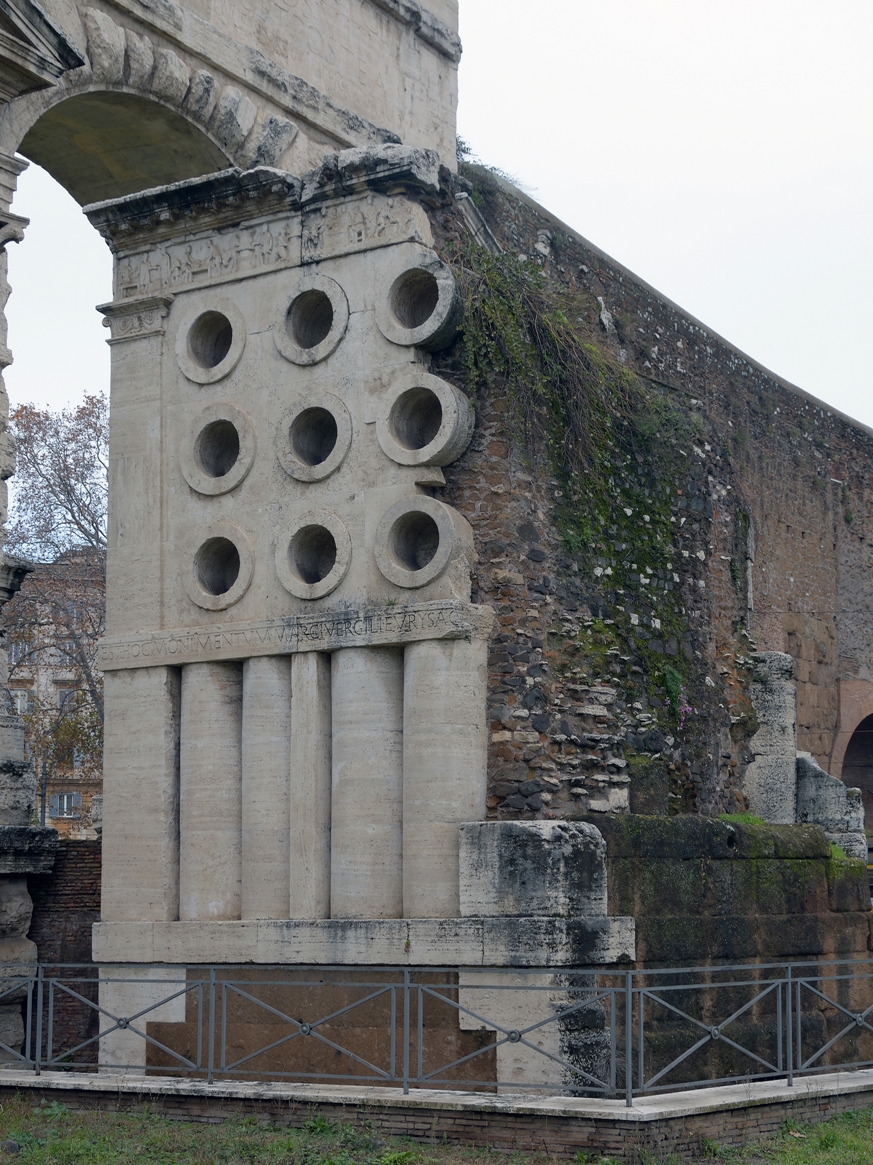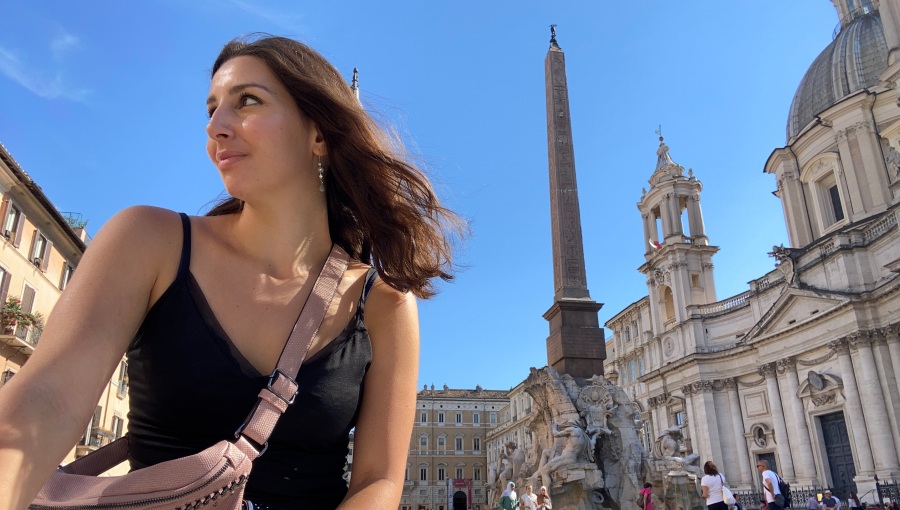Art, Passion, and Education: Art History Professor Crispin Corrado
Born in Providence, Rhode Island, Professor Crispin Corrado is a classical archaeologist specializing in Roman art. She has fieldwork experience in Pompeii and has worked as a curator in several museums in the U.S. and Italy. Professor Corrado, who holds a Ph.D. from Brown University, joined JCU in 2012. She currently teaches Art History courses at the undergraduate and graduate levels.
What brought you to Rome and JCU?
I initially planned to be in Rome for one year, while I finished my dissertation. I had always wanted to become a curator and had worked in several U.S. museums before coming to Italy. Once in Rome, I started to work at the Vatican Museums while completing my dissertation on ancient Roman portraits, and one year led to the next! Once I finished the Ph.D., I started teaching and found that I loved it even more than curatorial work. I’ve been teaching ever since! John Cabot is the most thrilling environment, academically rigorous with an incredible administration and Department of Art History. The students are fabulous – engaged, kind and curious. John Cabot has become my home.
How did you become interested in archeology?
When I was a child my parents always read me the Greek myths, the Iliad, and the Odyssey, and my father started teaching me Latin when I was five. Growing up in Hyde Park in Chicago, I had access to the Oriental Institute, home to incredible ancient Near Eastern artifacts. I knew that I wanted to spend my life studying ancient cultures, and thought I’d focus on Egypt and the Near East until I went to college. My very first class was a course on Pompeii, and the rest, as they say, is history! I remain very good friends with the professor of that course – she became a mentor, and after all these decades, she is like family.

Professor Crispin Corrado
Tell us about your fieldwork in Pompeii.
I have worked in Pompeii on several different projects, over the years. My first was with a project sponsored by the University of Maryland – a group studying under the great scholar Wilhelmina Jashemski was documenting the lararia or shrines in the houses throughout the ancient city. It was a magical experience, and I knew right then that I was in the right place. I later conducted my own MA research project in the city, which consisted of cataloging and studying a particular type of wall painting that had not yet been fully documented or understood. I spent six weeks in the Bay of Naples that summer, working in Pompeii, Herculaneum, Oplontis, and the other aristocratic villas in the area. It was really exhilarating to be given special access to the houses and sites, and permission to work there alone… and it was even more incredible to be able to study and make a contribution to scholarship on ancient Roman art.
After that, I returned to actually excavate at Pompeii for two seasons with the University of Rome “La Sapienza.” Every morning we were admitted to the site before it opened, and it was just us. We were digging in two locations – one in the Triangular Forum, and the other was right behind the main Forum. The dig directors were trying to discern the way that the city had developed, previous to its life as Roman. It was my first actual excavation, and so I learned the techniques from my Italian colleagues and instructors. Did I mention that I wasn’t yet fluent in Italian? Let’s just say that I learned a lot, and very quickly.
You have worked as a curator for the Vatican Museums. Can you tell us about this experience?
I was working on my dissertation inside the galleries of the Vatican Museums, and I had become friends with the curator of antiquities, who had given me permission to study the pieces I needed to study, and with whom I would meet regularly to talk about my project. While working in the galleries every day, I overheard tourists who were frustrated by the lack of didactic material in the galleries. There were no labels, no posters; there was no information. So, one day I marched into the curator’s office and told him what I had been experiencing. I said something like, “I’m here, sculpture is my specialty. I would be very happy to write your object labels!” He said, “Go ahead! Oh, and get a grant from the patrons of the Vatican Museums in order to fund this project.” So, I wrote up a proposal, it was accepted, and I went to work. I always advise my students to ask and to say yes to all work proposals – especially volunteer possibilities. Work hard at them, learn all that you can, show your value, and you will gain the personal connections and the work experience that will lead you to the next opportunity.
Tell us about your Ancient Roman and Mediterranean Mural Painting graduate course.
As I was proposing the course, I realized that we are physically in the best place in the world to study not just ancient Roman wall painting, but truly all ancient wall painting throughout the Mediterranean. It’s all here, or nearby enough. In the course, we study the tomb paintings of the Etruscans and travel to Cerveteri and Tarquinia (near Rome) to see examples in person. We also study the Bronze Age Aegean and are able to travel to Greece – specifically to Athens, as well as the island of Santorini for the ancient site of Akrotiri, and to Herakleion, in Crete, home to one of the most incredible archaeological museums in the world, which houses examples of painting from the palace at Knossos, among others. Again, we are in the best place in the world to study and see all of these precious, famous, influential paintings, and it is my pure joy to introduce our students to them and the sites themselves.

Tomb of Eurysaces the Baker by LivioAndronico2013
What is your teaching philosophy?
I have always felt that it is one’s own passion that is the best motivator, so my approach is twofold. First, I try to convey what I love about whatever it is I’m teaching – why it is incredible, why it is singular, why it matters, going over it very slowly – hoping to open students’ eyes to something new. Second, I try to encourage students to use that sort of inspiration, that way of looking and thinking in their own work, particularly when it comes to their assignments. I also encourage students to believe in their ideas, to know that their points of view matter – that it is important to read and think critically, for example, and that they should feel free to challenge established (and old) scholarly ideas, or even scholarly trends! Finally, I encourage students to remember that there is always more work to be done out there. They matter, and they can make a difference.
What do you like most about teaching in JCU’s MA in Art History program?
My colleagues in the Department of Art History and Studio Art are the best in the business. They know art and they know Rome, better than anyone. For that reason, I truly believe that our MA in Art History students are in the very best hands possible. I know that they will receive an education unlike any other. They will know the city, its history, and its art, and not just because they are introduced to those aspects by our incredible specialists, but also because they will have been there, physically! The students will visit the sites, the archives, the churches, the libraries. They will be able to participate in the culture here. I love being a part of this amazing program – a program, and a school, that I believe in with all my heart. I also love getting to know the students, who have been so interesting and wonderful, over the years, coming from such diverse backgrounds.
What are your upcoming projects?
I just submitted an article that I have been working on for a number of years, now, on the so-called “Tomb of the Baker” (the Monument of Eurysaces) in Rome. The article is a reassessment of the monument, which has been traditionally regarded as an ancient example of over-the-top, nouveau-riche ostentation in funerary architecture! In short, my article attempts to show that the monument was, instead, typical of the time and that, as such, it should be studied and appreciated for that aspect. I’m hoping to give the monument some respect! That research has led to an interesting discovery about Roman funerary sculpture, which is the subject of my current project. I am to present a paper on this to the Archaeological Institute of America, in January.





